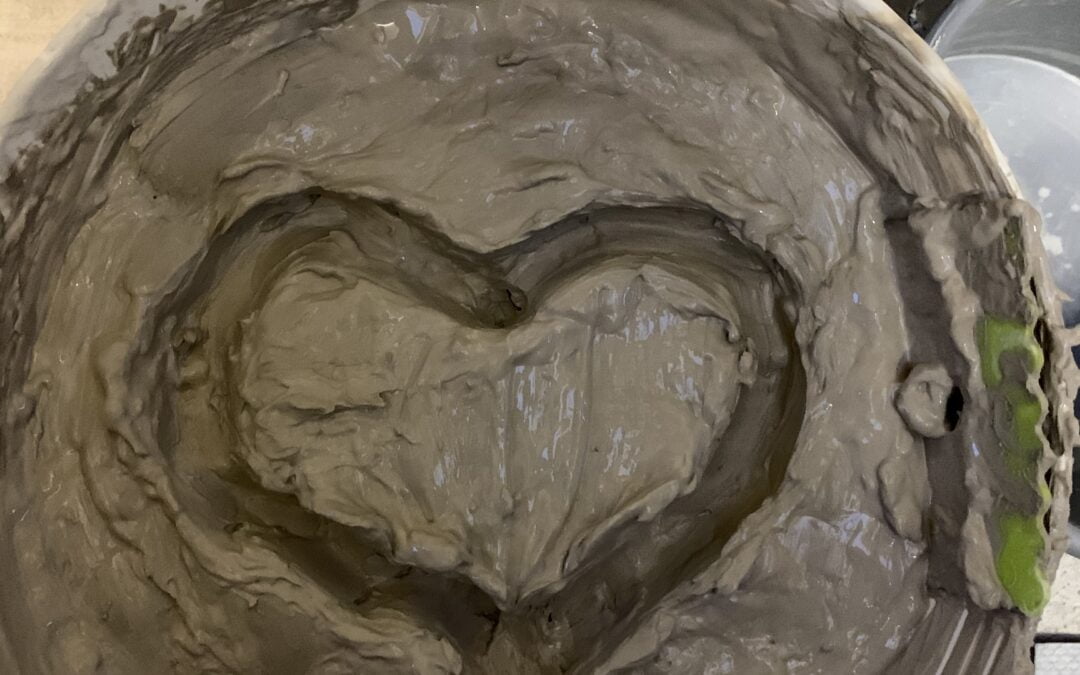One of the daily or, in any case frequent, tasks of a ceramic artist is the recycling of clay.
With the exception of a few of us, the majority of ceramicists buy their clay from a supplier in plastic form. Clay comes in 10-12kg bags ready to use. When you take it out of your bag, the clay is wedged and… off you go on your creative journey!
However, not every piece you start ends up to be a master piece. Especially in the beginning, you often end up with pieces that are flopped or in any way are unfit for firing or for turning. The good news is that you can recycle or reclaim clay multiple times if it hasn’t gone through a firing.
Like many other artists, working out of my home studio, I do not have a pugmill, which is a piece of equipment that homogenizes and de-airs the clay. I am therefore using low tech methods to recycle or reclaim my clay.
I generally use the clay slop (water mixed with fine clay) remaining after throwing as a basis, putting in dry clay scraps and other pieces and get the clay into a thick cream-like state which I then spread out on a plaster batt. The plaster batt has the function of sucking the moisture out of the clay, returning it into a plastic and workable consistency.
As a final step the clay requires wedging in order to homogenize and de-air the clay (in absence of a pugmill, elbow grease is the alternative), which is then ready to throw again. Mostly I do not require to recycle the clay multiple times, so I generally do not need to bother too much about the deterioration of the clay in terms of plasticity.
What I mean by deterioration of the clay, is that the clay becomes “short” in pottery jargon. “Short” is the word that’s used to describe clay that has low plasticity, where clay is prone to cracking when bending, stretching and shaping. Plasticity refers to a clay body’s ability to be formed into a shape, and to retain that shape; that’s why clay is called a “plastic” material.
Wet clay is “plastic” as described above, because its particles attract each other like magnets. Water allows the particles to move and slide and stay stuck together as we shape the clay. The particles can be small or medium or large sized particles and an optimum distribution of those particles will allow the clay to be better kept together when formed. In fact, when we only have one size of clay particles, there are a lot of gaps in between them and less overall points of contact bonding the clay body together, so when we bend or stretch a clay body containing only one particle size, because there are fewer bonds, a lot of them will break, causing cracking. This is what happens when clay is “short” as opposed to “plastic”.
By keeping the throwing water and using that as a basis for my reclaimed or recycled clay I make sure that this particle size distribution is guaranteed. When you notice that after some reclaiming exercises of your clay, it becomes less workable notwithstanding the use of your throwing slop, you might consider to wedge in fresh-out-of-the-bag clay as an additional alternative to upgrade the particle size distribution of your clay.
I hope this helps!
In case of any questions, please do not hesitate to reach out 😉


 My name is Elisa; I am a woman, a mum, a daughter, a friend and a wife… and a passionate ceramicist/potter.
My name is Elisa; I am a woman, a mum, a daughter, a friend and a wife… and a passionate ceramicist/potter. 



